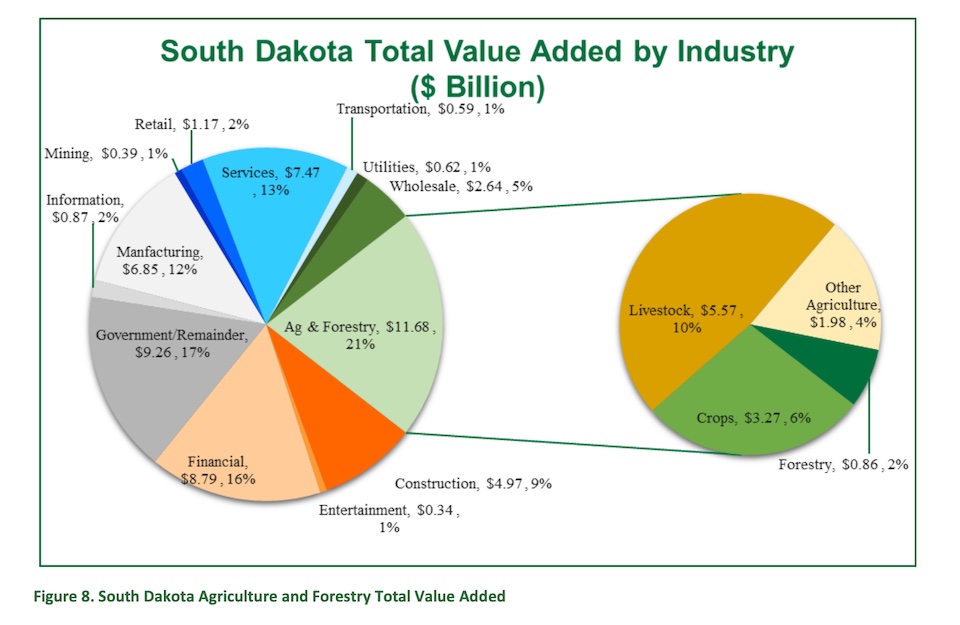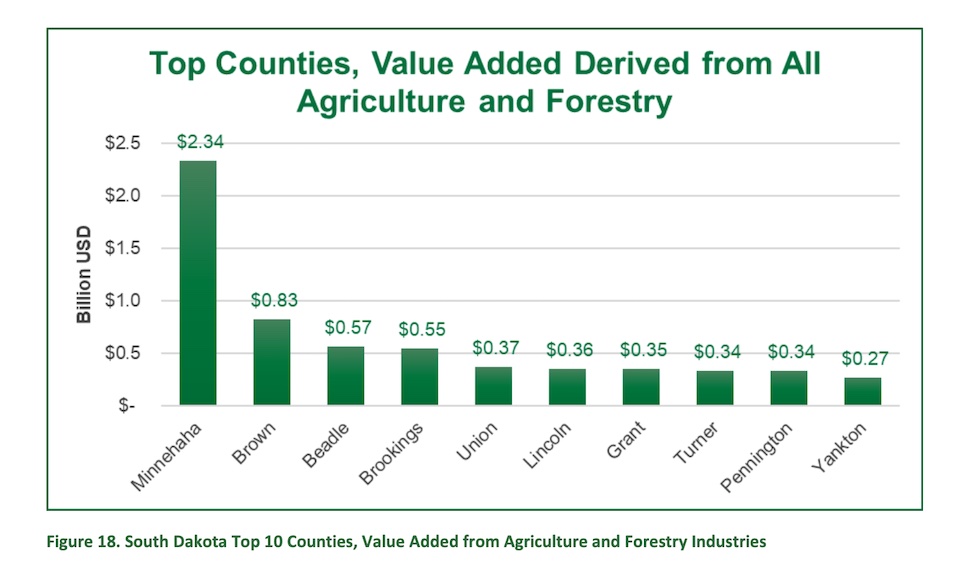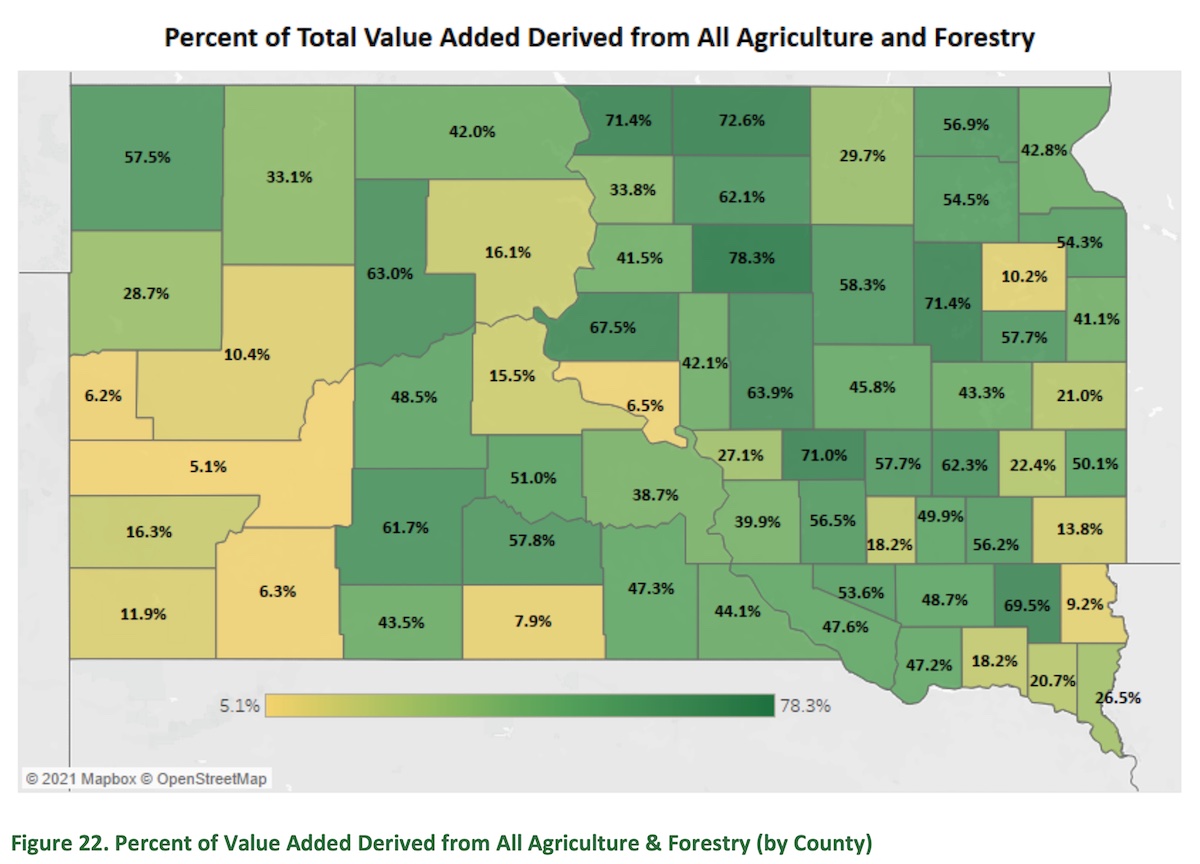South Dakota’s ag-industrial complex doesn’t cotton (corn? bean?) to hearing that agriculture generates only 5.78% of South Dakota’s gross domestic product. They thus feel compelled to cook up numbers making agriculture sound bigger than it is:
The Department of Agriculture and Natural Resources (DANR) in cooperation with AgUnited for South Dakota, South Dakota Dairy Producers, South Dakota Corn Utilization Council, Central Plains Dairy Foundation, and East River Electric Power Cooperative have released an economic contribution study of South Dakota Agriculture.
Based on the study agriculture, forestry, and related industries contribute:
- $32.1 billion to South Dakota’s economy which is 29.3 percent of South Dakota’s total economic output.
- 129,753 jobs in South Dakota which is 21.1 percent of all jobs in South Dakota.
- $11.7 billion in total value added including $5.6 billion from livestock production, $3.3 billion from corn production, $2 billion from other agriculture industries, and $860 million from forestry production.
Whereas the data I cited last week on ag’s share of SD GDP came from the United States Bureau of Economic Analysis, the industry-captured South Dakota Department of Agriculture (and Natural Resources) and industry lobbyists bought their study from private Iowa-based analysts Decision Innovation Solutions. Their job apparently was to roughly quadruple ag’s share of South Dakota’s economy and jobs from the BEA figures. To achieve that goal, they have to look at total economic output instead of gross domestic product. Total economic output counts all sales of intermediary and final products. Suppose Farmer Herman sells a cow to Demkota Beef for $500, and then Demkota sells the chopped-up meat to Ken’s Super Fair Foods for $1,000, and then Ken’s sells us Aberdonians that meat for $1,500. Total economic output triple-counts the raw moo-material and double-counts the slaughterhouse’s processing and says total sales were $3,000. Gross domestic product counts only the value added, the gross output minus the intermediate inputs, which in Herman-Demkota-Ken’s case is $1,500.
But even looking strictly at value-added, the Department’s contractors claim that ag constitutes 21.0% of South Dakota’s economy, not the 5.78% the USBEA found. To get to that point, the private analysts had to expand agriculture to include the first stage of processing:
To strike middle (and defensible) ground between including more than just farm level production and seeking to attribute excess economic activity to the agriculture industry, this analysis includes production agriculture plus the first round of value added to the process. For example, in addition to the production of livestock and poultry, we have also included the industries that process them (i.e., production, processing, slaughtering, and rendering). As mentioned, we have followed this same pattern of analyzing other agricultural industries (e.g., crops), forestry production and further processing (sawmills, etc.) [Decision Innovation Systems, “2021 Economic Contribution Study of South Dakota Agriculture, Ethanol, and Forestry,” July 2021].
By their methodology, DIS is able to slice up a pie chart to show agriculture as the biggest value-adding sector in South Dakota, followed by government and miscellaneous at 17%, finance at 16%, and services at 13%:

…and our top employing sector, followed by services, government+miscellaneous, and construction:

Using DIS’s definition of the ag sector to include the first level of processing, we find that the county with the most value add from the ag sector is Minnehaha, thanks largely to the output of the Smithfield Foods beef plant. The next biggest value-adding counties are Brown (Demkota Beef, AGP soybean plant…), Beadle (the turkey plant), and Brookings (Bel Brands cheese factory):

DIS also lists the ten counties where ag generates the highest percentage of local value added… which we may translate as the ten counties that…
- have the least diversified and thus least resilient economies;
- are the last places you want to have your money invested when there’s a drought;
- are most likely to depend on federal farm subsidies for their economic survival.

Thirteen other counties depend on ag for more than half of their added value. The county least dependent on agriculture is Pennington at 5.1%, followed by Lawrence, Oglala Lakota, Hughes, Todd, Lincoln, Codington, and Minnehaha:

Perhaps worth noting: of the 33 counties that lost population over the last decade, 25 rely on agriculture for more than 40% of their added value. of the 33 counties that gained population in the last decade, 18 get less than 40% of their added value from agriculture. In South Dakota counties, there appears to be a negative correlation between economic reliance on agriculture and population growth. As you may recall from the Commidity.com article that reported ag’s outsized share of South Dakota’s economy last week, Farm employment has decreased since World War II—you just don’t need as many people to produce crops and livestock, and jobs have sprung up faster in other sectors.
So whether ag is under 6% or over 21% of South Dakota’s added economic value or 29.3% of our total economic output, policymakers may not want to make increasing that percentage their goal. Growth in agriculture is fine, but sustaining and growing rural populations may depend more on expanding other economic sectors that offer more job opportunities in a more diverse and thus more robust economy.
“we have also included the industries that process them (i.e., production, processing, slaughtering, and rendering). As mentioned, we have followed this same pattern of analyzing other agricultural industries (e.g., crops), forestry production and further processing (sawmills, etc.)” – all of which jobs are dirty, dangerous, ill-paying, and thus most of them are performed by immigrants, some of whom don’t even show up on the books. Jeez, how dumb do they think we are?
Either tallying method must subtract the value of state agriculture subsidies as costs to the state: fuel tax, sales and use tax, even vehicle registrations.
You’re not even considering the economic activity generated by ag.
You have to account for machinery dealers, mechanics, fertilizer sales, chemical
sales, grain haulers, grain and inputs hauled by rail. If you took all of agricultural
activity out of South Dakota, it would be a pretty empty place. It’s hard to tell
where ag activity ends. Most of the small towns in South Dakota exist to
service ag. Oh yeah, ag manufacturing to.
Ag manufacturing too.
Sorry
Almost all the folks leaving big cities are moving to other, smaller metro areas (in SD that includes towns like Aberdeen and Watertown that anchor “micropolitan areas). The number of folks actively moving to truly rural/very small town America is a rounding error.
A few minutes of objective, critical thinking tells one why. Folks may well want “acreage” but they also want access to decent healthcare, at least a modest choice of social outlets and high schools large enough to offer their kids more than just the basic selection of courses.
As discussed here recently, many counties in central/north-central/northwestern SD saw their populations peak in 1930 and they often now have half or fewer folks now. It might make more sense to invest public $$ in buying out farms and ranches when they come up for sale and doing the work to turn them back into tall-and-short grass prairie, rather than continuing subsidies to prop up commodity production better done elsewhere.
Doesn’t agriculture take 21% of the states work to generate 6% of the states gross domestic profit?
Joe & Mark: I often wonder if it would be less expensive to make all farmers and ranchers government employees than it is to pay farm and ranch subsidies and give them generous tax breaks.
My ARK fund news note included a blurb on bio-engineering using RNA Interference to protect crops (and the environment). (Expect opposition from the usual suspects.)
“Cost Declines in RNA Synthesis Could Revolutionize Crop Protection
By Pierce Jamieson | @PierceARK Research Associate
Historically, to tackle agricultural pest control, agrochemical developers have focused on small molecule fungicides, herbicides, and insecticides, each of which has raised questions. While the degree of target-specificity has improved over time, regulators and activist organizations have expressed concerns about their impacts on human and environmental health. As a result, the race is on to find cheaper, more specific, and easier-to-develop crop protection technologies.
RNA interference (RNAi), a natural cellular process, could be that technology. RNAi occurs when double-stranded RNA (dsRNA) is introduced into cells of eukaryotes like plants, insects, fungi, and animals. Because dsRNA is involved in viral infection, cells sense danger and have evolved ways to detect and destroy it. Once destroyed, the remaining fragments of dsRNA are loaded into the “RNA-induced silencing complex” (RISC) which uses them like the “ctrl-f” function on a word processor to find and destroy other molecules of the same origin.
Researchers at Greenlight Bio have found genes critical to the survival of certain pests and are genus-, or even species-specific in their action. In response to spraying the dsRNA of these genes over fields, the pests turn their own RISCs against themselves, silencing their critical genes and causing their own demise. Posing little risk to humans and the environment, the sprayed dsRNA lasts only days in the field before degrading naturally.
While conventional RNA synthesis manufacturing techniques are prohibitively expensive, Greenlight’s revolutionary technique offers four to five orders of magnitude in cost declines. Today, RNA synthesis costs range from $1,000 to $10,000 per gram, and each acre requires four grams for protection.”